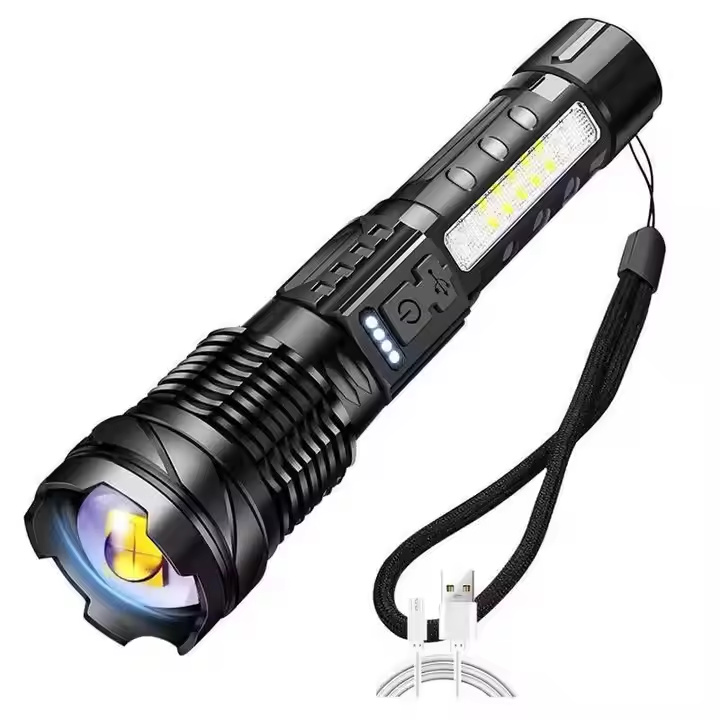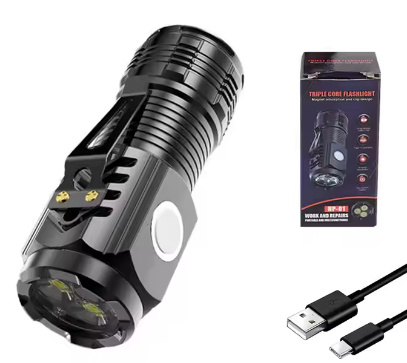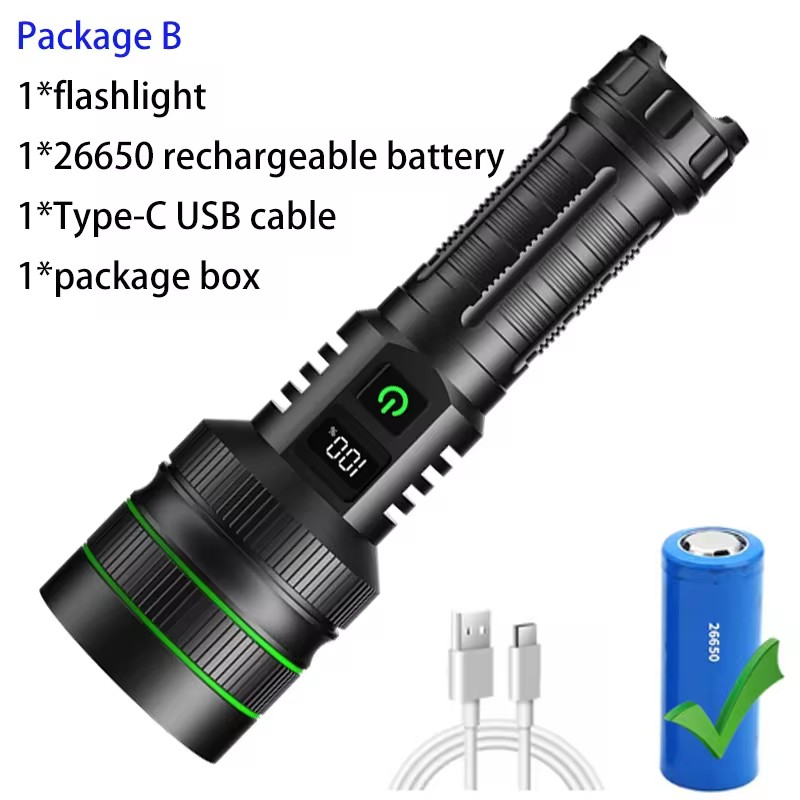How to Create Unique Flashlight Designs for Bulk Purchases

Unique flashlight designs can elevate your brand, create memorable gifts, or boost resale value. If you're wondering how to create unique flashlight designs for bulk purchases, a well-designed flashlight combines creativity and functionality, making it a practical yet impactful item. Bulk purchasing customized flashlights offers several advantages. It reduces the cost per unit, helping you maximize your budget. These flashlights also serve as effective promotional tools, enhancing brand visibility through repeated use. For events or corporate giveaways, they foster customer loyalty and engagement. Bulk orders ensure consistent quality, appealing to eco-conscious buyers. Whether you aim to create an advanced flashlight or an insanely bright LED flashlight, the possibilities are endless. Let your design shine as brightly as the light it emits.
Key Takeaways
Know what your audience needs to make useful flashlights. Design them for specific uses like camping or emergencies.
Include features people want in your designs. Things like waterproofing, easy carrying, and rechargeable batteries make them better.
Pick materials carefully to keep costs low but quality good. Recycled plastic is cheap, and aluminum is strong and fancy.
Offer custom options like logos and cool packaging. This helps your flashlights stand out as gifts or ads.
Work with trusted makers to keep quality steady. Check products often to make sure they stay great.
Understanding the Target Audience for Flashlight Designs
Defining the Purpose of the Flashlights
Understanding the purpose of your flashlight design is the first step in creating a product that resonates with your audience. Flashlights serve various purposes, and customization allows you to tailor them to specific needs.
Custom logo flashlights work well as trade show giveaways, leaving a lasting impression on potential clients.
Retailers often use them as practical, everyday items that appeal to a wide audience.
Flashlights designed for emergencies are essential for cars, workplaces, and homes.
Outdoor enthusiasts value flashlights for camping trips, hiking, and other adventures.
When you define the purpose, you can align the design with the intended use, ensuring it meets the expectations of your target audience.
Identifying End-User Preferences
To create a flashlight that stands out, you must consider what your end-users value most. Preferences vary depending on lifestyle and usage.
Outdoor enthusiasts prioritize waterproofing, shock resistance, and durability. Materials like aircraft-grade aluminum are popular for their strength.
Urban users often prefer sleek, portable designs that fit easily into bags or pockets.
Rechargeable flashlights are highly sought after, as they reduce reliance on disposable batteries.
Compact and lightweight designs appeal to campers and backpackers.
Features like adjustable light modes, ergonomic grips, and eco-friendly materials enhance user satisfaction.
By identifying these preferences, you can incorporate features that make your flashlight both functional and appealing.
Considering Budget and Market Demands
Balancing cost and quality is crucial when designing flashlights for bulk purchases. You need to consider the budget constraints of your target market while ensuring the product remains competitive.
Lightweight flashlights weighing around 250 grams strike a balance between portability and durability.
Rechargeable options may have a higher upfront cost but offer long-term savings for users.
Eco-conscious buyers increasingly demand renewable energy options and sustainable materials.
For professional use, handheld penlights provide portability without compromising functionality.
Understanding market demands helps you create a flashlight that aligns with both user expectations and budget considerations. This approach ensures your design remains practical and marketable.
How to Brainstorm Unique Flashlight Design Elements

Selecting Colors and Shapes
Colors and shapes play a significant role in making your flashlight stand out. You can use vibrant colors to grab attention or muted tones for a professional look. For example, bright colors like orange or yellow are ideal for outdoor or emergency flashlights, as they are easy to spot in low-light conditions. Sleek black or metallic finishes work well for corporate or luxury designs.
Shapes also influence functionality and appeal. Cylindrical designs are classic and easy to grip, while flat or rectangular shapes fit better in pockets or bags. You might even consider unique shapes, such as hexagonal designs, to prevent rolling on uneven surfaces. When brainstorming, encourage creativity by fostering a supportive environment. Open discussions without fear of judgment can lead to innovative ideas that combine aesthetics with practicality.
Adding Functional and Multi-Purpose Features
Incorporating functional features can elevate your flashlight design. Think about adding multi-purpose elements that cater to specific needs. For instance, a flashlight with a built-in compass or bottle opener appeals to outdoor enthusiasts. Rechargeable LED options reduce battery waste, making them eco-friendly and cost-effective.
For industry-specific applications, consider features like weather resistance or high-lumen output. Materials such as anodized aluminum ensure durability in extreme conditions, while long run times enhance reliability. Compact designs with adjustable light modes are practical for everyday use. By focusing on functionality, you can create a flashlight that meets diverse user demands.
Prioritizing Ergonomics and Portability
Ergonomics and portability are essential for user satisfaction. A well-designed flashlight should feel comfortable in the hand and be easy to carry. Lightweight materials like aluminum or plastic reduce strain during extended use. Textured grips or rubberized coatings improve handling, especially in wet or slippery conditions.
Portability matters for users who need to carry their flashlight daily. Compact designs that fit into pockets or attach to keychains are highly desirable. For outdoor or professional use, consider adding clips or straps for convenience. By prioritizing these elements, you ensure your flashlight is both practical and user-friendly.
Choosing Materials for Cost-Effective Flashlight Designs
Comparing Material Options
Choosing the right materials for your flashlight design impacts both durability and cost. Recycled plastics have become a popular choice due to their affordability and reliability. This sustainable option not only reduces production costs but also appeals to eco-conscious buyers. For a more premium feel, aluminum offers a sleek finish and excellent heat dissipation. However, it tends to be more expensive and can dent under pressure.
The table below compares the two most common materials used in flashlight production:
Material | Durability | Cost Implications |
|---|---|---|
Aluminum | Scratches and warps easily; dents are permanent. | Generally more expensive due to metal. |
Plastic | Scratches do not expose underlying color; more resilient to wear. | Typically less expensive and lighter. |
By understanding these differences, you can select materials that align with your design goals and budget.
Balancing Quality with Affordability
Balancing quality and affordability requires careful planning. Start by requesting samples from suppliers to evaluate material quality. This step helps you avoid defective products and ensures consistency. Conduct random inspections during production to maintain high standards. Partnering with reliable suppliers also guarantees better results.
Negotiating bulk discounts is another effective strategy. It allows you to reduce costs without compromising on quality. For example, using rechargeable LED flashlights can save money in the long run by eliminating the need for disposable batteries. This approach not only enhances affordability but also improves the product's appeal to environmentally conscious consumers.
Ensuring Scalability for Bulk Orders
Scalability is crucial when producing flashlights in bulk. Materials must support large-scale manufacturing without sacrificing quality. Rechargeable batteries, for instance, offer reliability and convenience, especially for users in remote areas. Partnering with suppliers who have strong reputations ensures consistent quality across all units.
The table below highlights key factors to consider for scalability:
Factor | Description |
|---|---|
Battery Life | Critical for reliability, especially in remote areas. Rechargeable options offer convenience. |
Cost-Effectiveness | Balancing quality and affordability is essential. Negotiating bulk discounts enhances value. |
Supplier Reputation | Reviews and certifications ensure consistent quality and safety compliance. |
Compliance | Certifications like CE, RoHS, and ISO indicate adherence to safety and performance standards. |
By focusing on these factors, you can ensure your flashlight design meets market demands while remaining scalable for bulk production.
Customization Options for Flashlight Bulk Purchases

Engraving Logos and Adding Branding
Adding your logo to a flashlight is one of the most effective ways to enhance brand visibility. Laser engraving is the preferred method for imprinting logos. It creates a durable mark that resists wear and tear, unlike screen-printed logos that may fade or rub off when exposed to certain chemicals. This method ensures your branding remains intact even after prolonged use. You can also experiment with placement, such as engraving the logo on the flashlight's barrel or near the LED lens, to maximize visibility. By incorporating branding into the design, you create a product that not only serves a functional purpose but also promotes your business effectively.
Designing Custom Packaging
Custom packaging adds a professional touch to your flashlight design and makes it more appealing to buyers. You can explore innovative ideas to make your packaging stand out:
Use unique shapes and styles for the boxes to grab attention.
Include custom branding elements like logos or mascots to reinforce your brand identity.
Add protective features to prevent damage during shipping or handling.
For example, a sleek box with a foam insert can hold the flashlight securely while showcasing its premium quality. Custom packaging not only enhances the unboxing experience but also increases the perceived value of your product.
Offering Variations in Colors and Features
Offering multiple color and feature options allows you to cater to a broader audience. Bright colors like red or yellow work well for outdoor or emergency flashlights, as they are easy to spot. Sleek metallic finishes appeal to corporate buyers looking for a professional look. You can also provide variations in LED brightness levels, such as high-lumen options for outdoor enthusiasts or dimmable settings for everyday use. Including features like rechargeable batteries or adjustable light modes adds versatility to your design. By offering these options, you ensure your flashlight meets diverse customer needs while standing out in the market.
Manufacturing and Quality Assurance for Flashlight Designs
Prototyping and Testing
Prototyping and testing are essential steps in creating a reliable flashlight design. You can follow these steps to ensure your prototype meets expectations:
Decide the level of realism required for the prototype.
Choose materials that simulate the final product's look and feel.
Select a prototyping method based on the desired realism and material.
Create a visual prototype if you only need to showcase the design.
Develop a functional prototype to test mechanisms and part fits.
Combine functionality and aesthetics in a functioning visual prototype to closely resemble the final product.
Testing ensures the flashlight performs as intended. Evaluate features like LED brightness, battery life, and durability under different conditions. This process helps identify potential flaws early, saving time and resources during production.
Tip: Always test prototypes in real-world scenarios to ensure they meet user expectations.
Partnering with Reliable Manufacturers
Choosing the right manufacturer is critical for producing high-quality flashlights. Look for manufacturers who invest in development and hold certifications like CE, RoHS, or ISO. Evaluate their minimum order quantity to ensure it aligns with your needs.
Criteria | Details |
|---|---|
Product Quality | Durable materials, high-performance LEDs, and certifications. |
Customization Options | Branding, design, and functional modifications. |
Pricing | Competitive pricing without compromising quality. |
Production Capacity | Ability to handle bulk orders and meet deadlines. |
Reputation | Positive reviews, testimonials, and case studies. |
After-Sales Support | Warranty, return policies, and customer service availability. |
Partnering with a reliable manufacturer ensures consistent quality and timely delivery. This step is crucial for maintaining your brand's reputation.
Implementing Quality Control Processes
Quality control guarantees that your flashlight design meets high standards. Start by integrating customer feedback to align the product with user expectations. Maintain clean and organized production facilities to reduce contamination risks. Regularly inspect equipment to ensure efficiency and prevent defects.
Train employees on quality control best practices. This training fosters a culture of quality and ensures everyone understands the importance of standardized procedures. Set measurable quality standards, focusing on metrics like LED brightness, battery performance, and durability.
Note: Conduct in-process testing to catch issues early and avoid costly recalls.
Advanced technologies like predictive analytics and automated assembly lines can further enhance quality. These tools help identify potential defects and ensure consistent production standards.
Creating unique flashlight designs for bulk purchases involves several key steps. Start by understanding your audience and their needs. Brainstorm creative design elements that align with their preferences. Select materials that balance quality and cost. Add customization, such as logos or brand colors, to make your flashlight a memorable gift. Partner with reliable manufacturers to ensure consistent quality and safety compliance. High-quality designs enhance brand visibility and foster customer loyalty. Collaborate closely with suppliers to maintain standards and meet deadlines. With these strategies, you can confidently create flashlights that stand out in the market.
FAQ
1. Why should you customize flashlights for bulk purchases?
Customization helps your flashlights stand out. It enhances brand visibility and creates a memorable impression. Whether for corporate giveaways or resale, personalized designs add value. They also allow you to meet specific user needs, making your product more appealing and functional.
2. What is the best material for durable flashlight designs?
Aluminum is a top choice for durability. It resists wear and dissipates heat effectively. For a budget-friendly option, recycled plastic works well. It offers resilience and appeals to eco-conscious buyers. Choose based on your audience's preferences and your budget.
3. How can you ensure quality in bulk flashlight production?
Partner with reliable manufacturers who hold certifications like CE or ISO. Conduct regular inspections during production. Test prototypes under real-world conditions. Implement quality control processes to maintain consistency. These steps ensure your flashlights meet high standards.
4. What features make a flashlight design unique?
Unique designs often include multi-purpose features like built-in compasses or bottle openers. Vibrant colors, ergonomic grips, and rechargeable batteries also add appeal. Consider user preferences and market trends to create a flashlight that stands out.
5. How do you choose the right manufacturer for bulk orders?
Look for manufacturers with positive reviews and proven experience. Check their production capacity and customization options. Ensure they offer competitive pricing without compromising quality. Strong after-sales support, like warranties, is also essential for a smooth collaboration.
Tip: Always request samples before committing to a large order. This ensures the manufacturer meets your expectations.
See Also
Essential Guidelines for Selecting Private-Label Flashlights
How to Select Ideal LED Flashlights for Bulk Orders
Tips for Finding Premium Flashlights for Wholesale Buying
About US
Follow Us
Hello,Friend,
I am Mary from Helius, we are manufacturer of LED lighting products with more than a decade of experiences.
We offer hot selling products in market and guarantee the quality with competitive cost.
Let’s have more discussion on your inquiry.
Or you can reach out me via what’s up/tele gram +8618123952945 if it’s favorable to you.
Address
4th Floor, Building A16, Intelligent terminal industrial park of Silicon Valley, Dafu Industrial Zone,Guanlan, Shenzhen, 518110 China
Contacts
mary@heliuslights.com
heliuslight04@hotmail.com
+0086 18123952945
